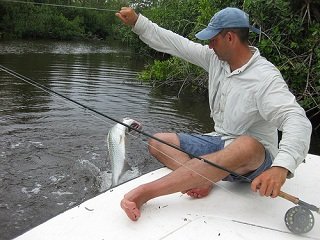 Tarpon are arguably the most exciting light tackle inshore species in the water today. With adults sometimes weighing in over 100 pounds, a notorious habit of leaping from the water when hooked, and a shy attitude that makes enticing them a challenge, it’s no secret why tarpon are a highly prized fish. However, while stalking the flats for large tarpon is an amazing experience, you can also get off the beaten path to find an exciting fight with the Silver King. Locals in tarpon country will tell you that you can easily find prize fish hiding in the shallow, hidden rivers of the backcountry with nothing more than a small boat and your normal tackle.
Tarpon are arguably the most exciting light tackle inshore species in the water today. With adults sometimes weighing in over 100 pounds, a notorious habit of leaping from the water when hooked, and a shy attitude that makes enticing them a challenge, it’s no secret why tarpon are a highly prized fish. However, while stalking the flats for large tarpon is an amazing experience, you can also get off the beaten path to find an exciting fight with the Silver King. Locals in tarpon country will tell you that you can easily find prize fish hiding in the shallow, hidden rivers of the backcountry with nothing more than a small boat and your normal tackle.
When seeking tarpon in such hidden locations, the important thing is to keep a steady focus on tarpon behavior and look for the optimal conditions and signs that the fish may be near. In colder months, tarpon will seek warm water, so any runoff from plants or factories is your best bet, along with bridges and canals. Also, due to a swim bladder that provides buoyancy, as well as enables them to breathe underwater, they need to surface every now and then to take in air. Looking for this surface activity will help you spot them as well.
Your tarpon gear needs to be suited to handle such a large fish, so a 7-foot, medium to medium-heavy action rod is a good start. You reel needs to be able to hold heavy line, as well. I also suggest using a fluorocarbon leader between three and six feet. Of course, fly anglers won't have to feel left out, as heavier fly setups will work well. Live bait, such as mullet, shrimp, ladyfish, and threadfins will work with tarpon, but if you want to bring a few lures to the backcountry, then surface poppers (clown patterns work very well) and metallic spoons are a good choice. Jigs with lighter colors work well too, but whatever approach you use, be sure to use strong enough hooks because tarpon will bend sub-par hooks.
Because of their skittish nature, stealth is the key tool you’ll need when seeking tarpon. When you see tarpon rolling and surfacing, try to predict where the fish are heading and place your lure ahead of them. Resist the urge to fire up the motor and chase them down, as they will make a hasty escape when they hear movement. Should you be fortunate enough to hook into a tarpon, prepare yourself for the fight of your life. Due to their habit of leaping and head shaking, tarpon are infamous for throwing hooks. To keep a good hook set, point your rod tip at the fish when it shakes its head, as keeping a little slack on the line when this happens will keep the hook from being pulled free.
If you want to get away from the open water and flats and get down and dirty to find tarpon, be sure to check with local guides or bait shops to see where the best spots are. Not only will they be able to clue you in on good locations, but they’ll also have just what you need to get the job done. As with any species, be sure to handle tarpon properly and make sure they’re fully revived and ready to swim on their own before releasing them. They’re called the Silver King for a reason, so respect for nature and such a powerful and majestic species is important.








